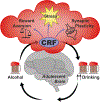Biological intersection of sex, age, and environment in the corticotropin releasing factor (CRF) system and alcohol
- PMID: 32217364
- PMCID: PMC7350391
- DOI: 10.1016/j.neuropharm.2020.108045
Biological intersection of sex, age, and environment in the corticotropin releasing factor (CRF) system and alcohol
Abstract
The neuropeptide corticotropin-releasing factor (CRF) is critical in neural circuit function and behavior, particularly in the context of stress, anxiety, and addiction. Despite a wealth of preclinical evidence for the efficacy of CRF receptor 1 antagonists in reducing behavioral pathology associated with alcohol exposure, several clinical trials have had disappointing outcomes, possibly due to an underappreciation of the role of biological variables. Although he National Institutes of Health (NIH) now mandate the inclusion of sex as a biological variable in all clinical and preclinical research, the current state of knowledge in this area is based almost entirely on evidence from male subjects. Additionally, the influence of biological variables other than sex has received even less attention in the context of neuropeptide signaling. Age (particularly adolescent development) and housing conditions have been shown to affect CRF signaling and voluntary alcohol intake, and the interaction between these biological variables is particularly relevant to the role of the CRF system in the vulnerability or resilience to the development of alcohol use disorder (AUD). Going forward, it will be important to include careful consideration of biological variables in experimental design, reporting, and interpretation. As new research uncovers conditions in which sex, age, and environment play major roles in physiological and/or pathological processes, our understanding of the complex interaction between relevant biological variables and critical signaling pathways like the CRF system in the cellular and behavioral consequences of alcohol exposure will continue to expand ultimately improving the ability of preclinical research to translate to the clinic. This article is part of the special issue on Neuropeptides.
Keywords: Adolescence; CRH; Environmental enrichment; Ethanol; Sex-differences; Stress.
Copyright © 2020 Elsevier Ltd. All rights reserved.
Conflict of interest statement
Declaration of competing interest The authors have no conflicts of interest to declare.
Figures



References
Publication types
MeSH terms
Substances
Grants and funding
LinkOut - more resources
Full Text Sources
Medical
Research Materials

